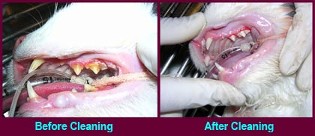 Dental health is a very important part of your pet’s overall health. By the time your pet is 3 years old, he or she will very likely have some early evidence of periodontal disease, which will worsen as your pet grows older if effective preventive measures aren’t taken. Early detection and treatment are critical, because advanced periodontal disease can cause severe problems and pain for your pet. Periodontal disease doesn’t just affect your pet’s mouth. Other health problems found in association with periodontal disease include kidney, liver, and heart muscle changes.
Dental health is a very important part of your pet’s overall health. By the time your pet is 3 years old, he or she will very likely have some early evidence of periodontal disease, which will worsen as your pet grows older if effective preventive measures aren’t taken. Early detection and treatment are critical, because advanced periodontal disease can cause severe problems and pain for your pet. Periodontal disease doesn’t just affect your pet’s mouth. Other health problems found in association with periodontal disease include kidney, liver, and heart muscle changes.
Your pet’s teeth and gums should be checked at least once a year by your veterinarian to check for early signs of a problem and to keep your pet’s mouth healthy.
All pets are at risk for developing dental problems. If your pet does, or has ever, displayed any of the warning signs below, periodontal disease may be present and a trip to the veterinarian would be the best course of action.
1. Bad breath (one of the 1st signs)
2. Yellow-brown crust on the teeth near the gum line
3. Red, swollen or bleeding gums
4. Lack of interest in eating, or pain while eating; change of chewing habits
5. Abnormal drooling
6. Loose or missing teeth
THERE ARE MANY CONTRIBUTING FACTORS TO THE ONSET OF DENTAL DISEASE:
1. POOR ORAL HYGEINE: Ignoring the condition of your pet's mouth can lead to periodontal disease, tooth loss and other health problems.
2. BREED: Periodontal disease is more common in smaller dogs and pure breed cats.
3. AGE: The risk of your animal showing signs of oral disease increases as they grow older.
